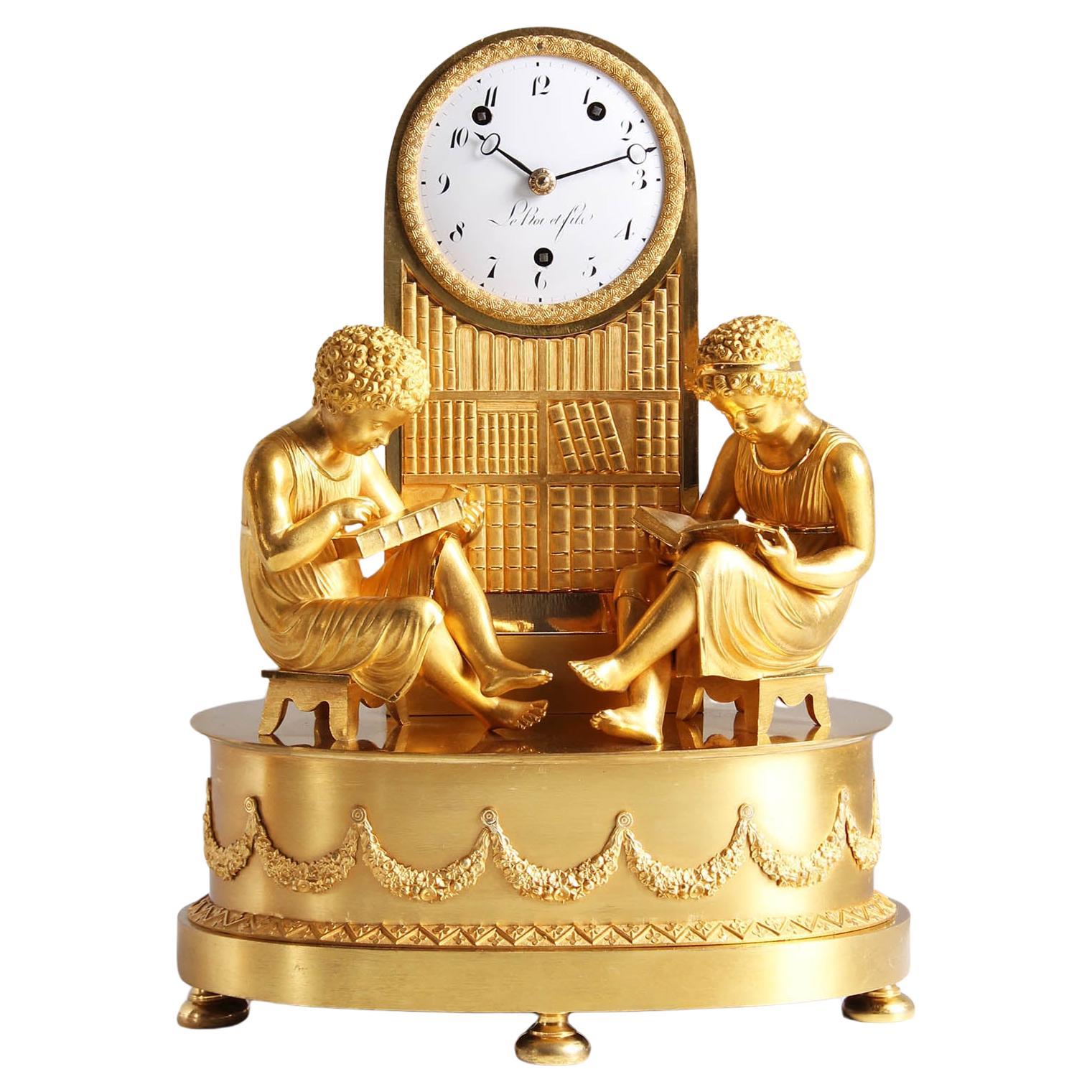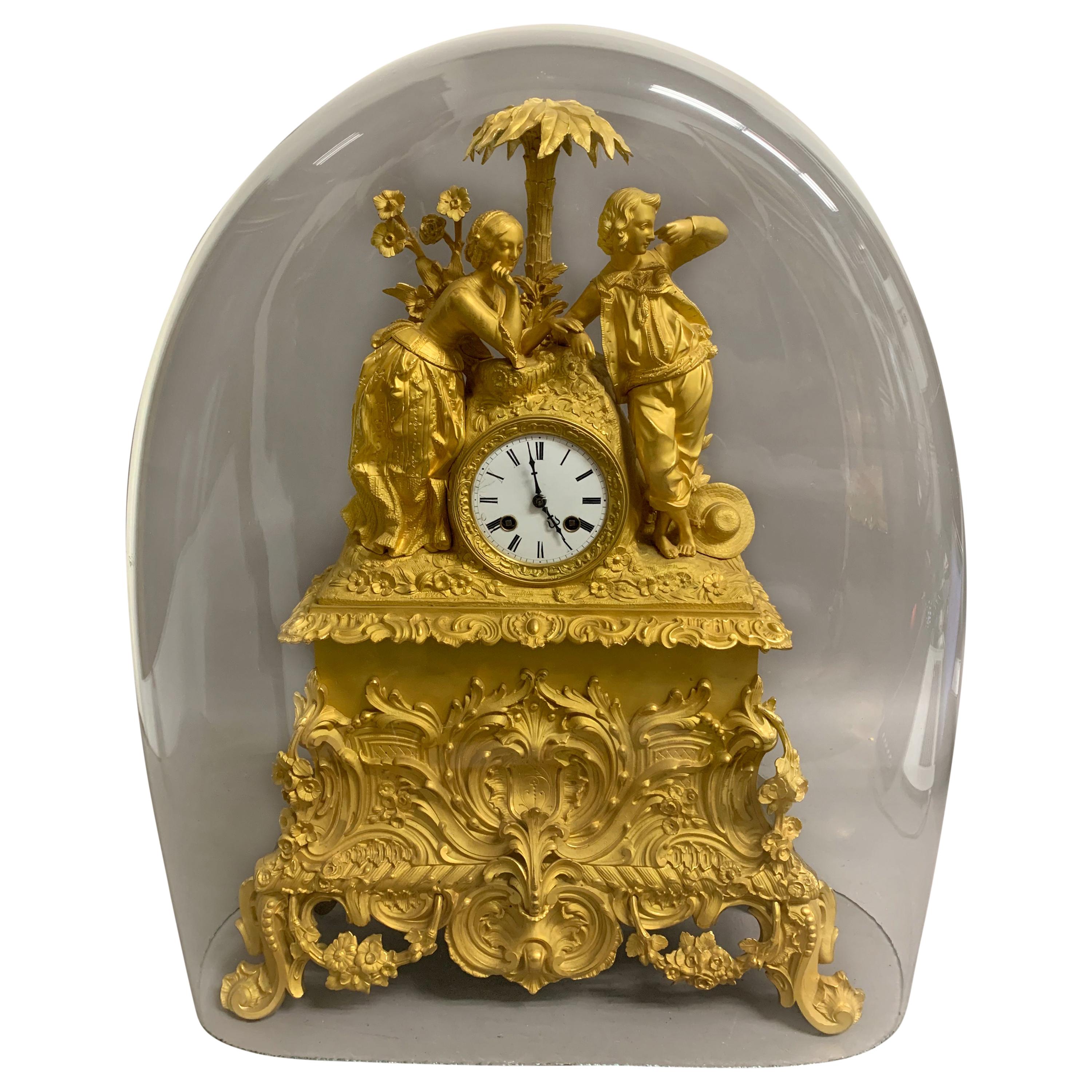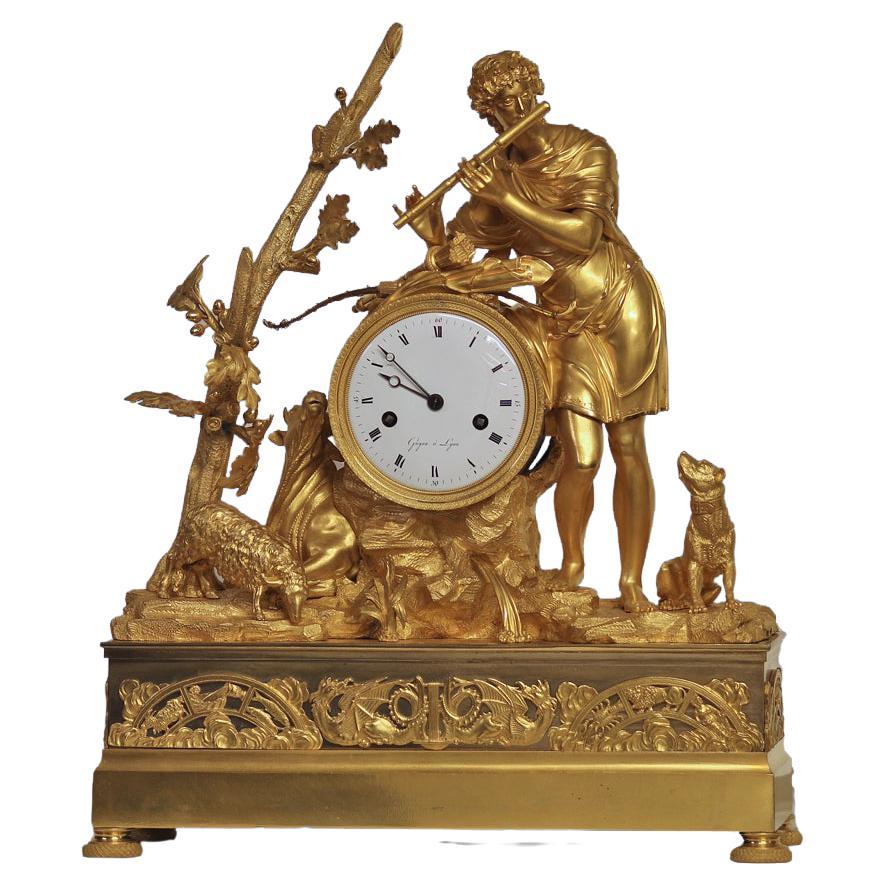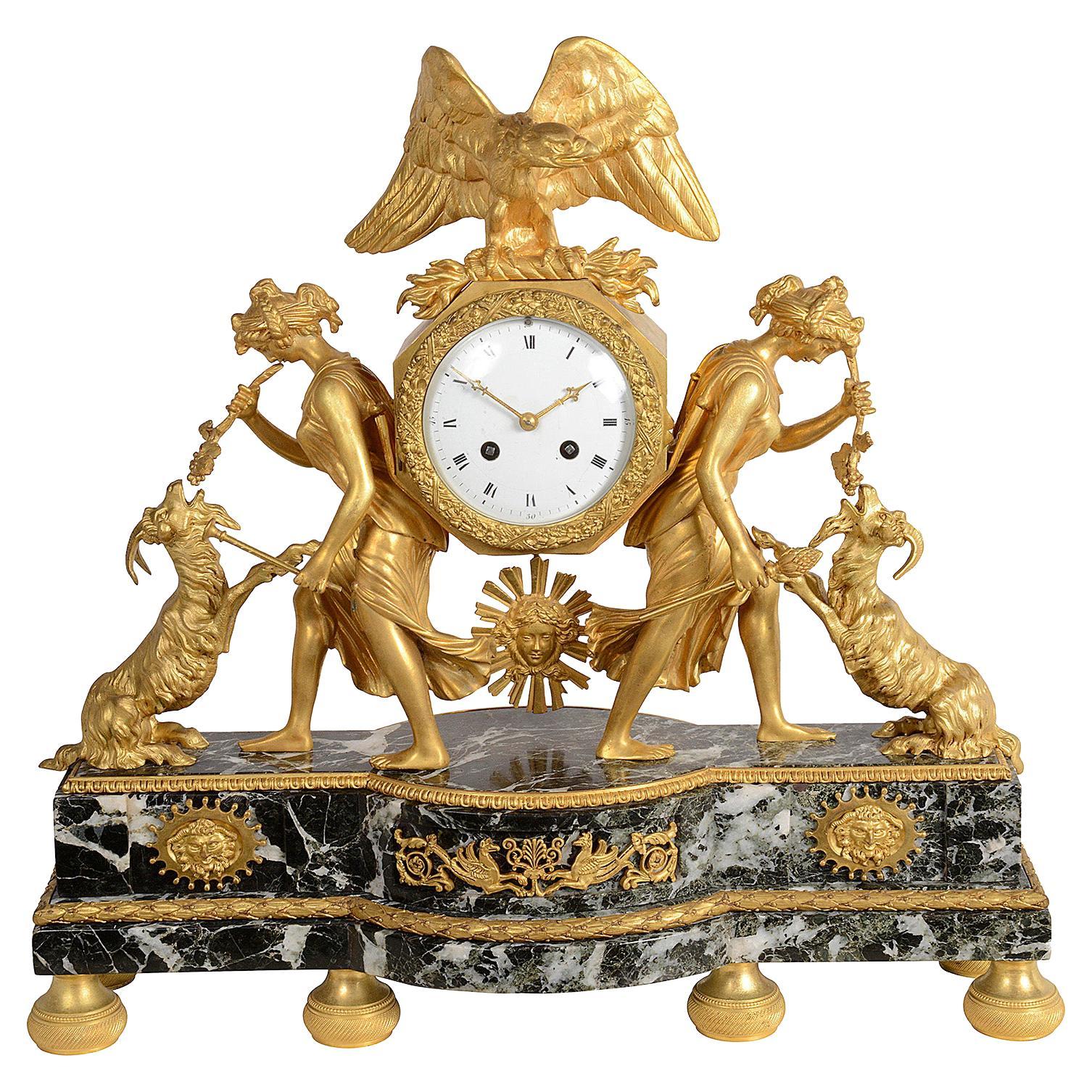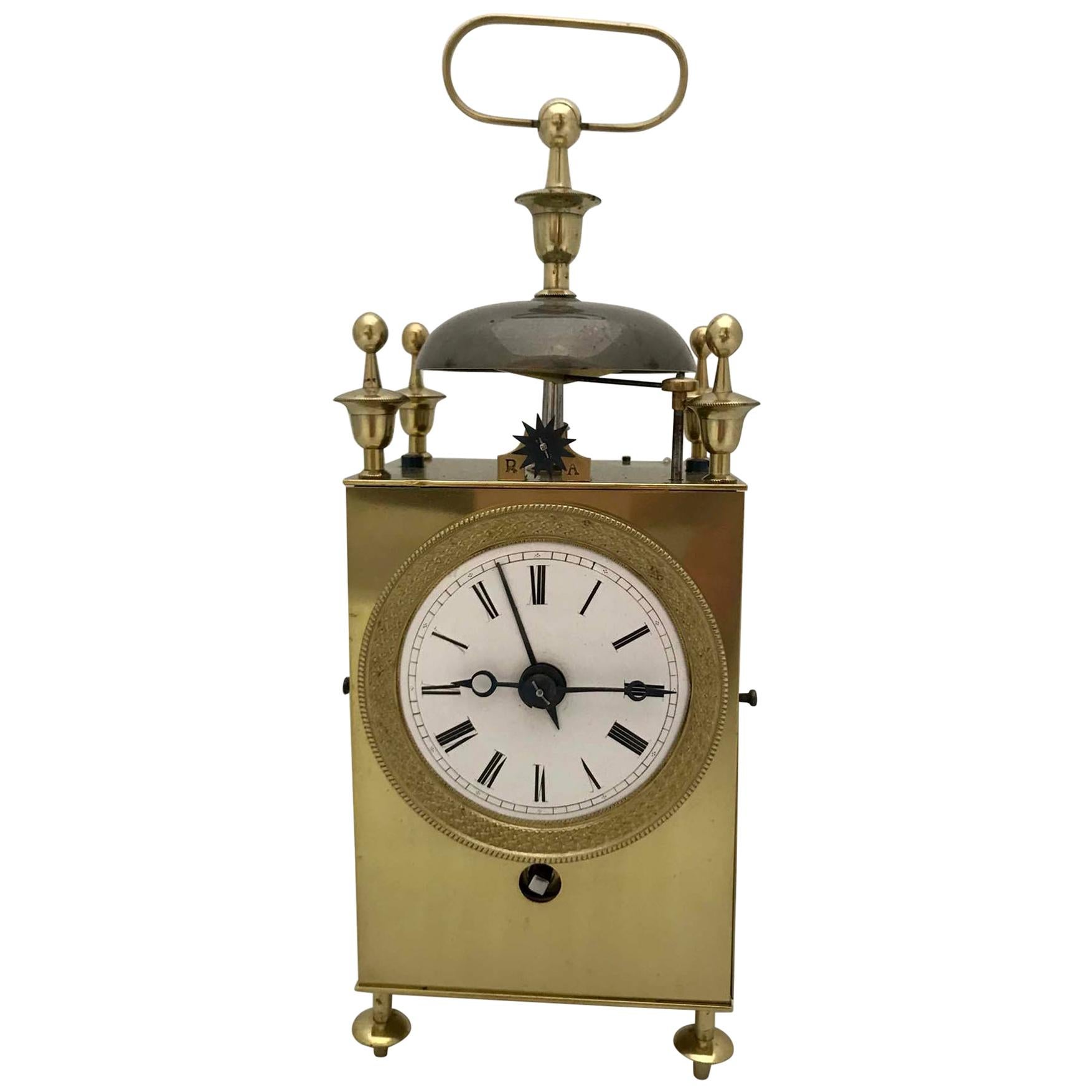Items Similar to Lovely Ormolu Clock "à la balançoire", France, Circa 1820
Want more images or videos?
Request additional images or videos from the seller
1 of 6
Lovely Ormolu Clock "à la balançoire", France, Circa 1820
About the Item
Floral and decorated neoclassical ormolu clock, figuring two baluster columns joined together by a floral arch, and topped by a crown of roses. Roman numbers indicate hours. In the arch, a woman dressed in antic style is sitting on a mobile swing suspended. Four round feet support the clock.
- Dimensions:Height: 15.75 in (40 cm)Width: 6.7 in (17 cm)Depth: 3.94 in (10 cm)
- Style:Restauration (Of the Period)
- Materials and Techniques:
- Place of Origin:
- Period:
- Date of Manufacture:circa 1820
- Condition:
- Seller Location:PARIS, FR
- Reference Number:
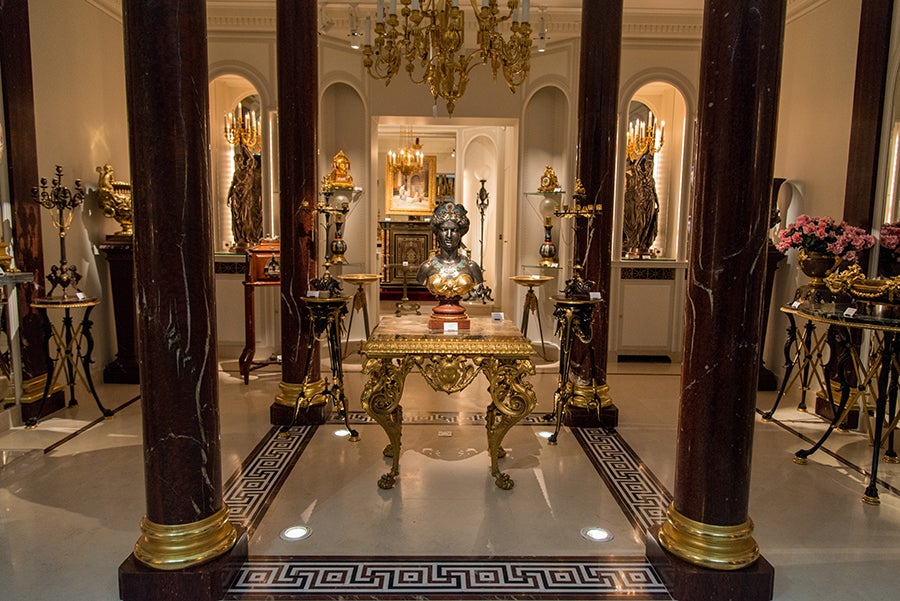
About the Seller
4.9
Vetted Seller
These experienced sellers undergo a comprehensive evaluation by our team of in-house experts.
Established in 1997
1stDibs seller since 2018
73 sales on 1stDibs
Typical response time: <1 hour
Associations
International Confederation of Art and Antique Dealers' Associations
- ShippingRetrieving quote...Ships From: PARIS, France
- Return PolicyA return for this item may be initiated within 7 days of delivery.
More From This SellerView All
- Fine Neo-Greek Clock Set by H. Houdebine, France, Circa 1867By Henri HoudebineLocated in PARIS, FRDial signed H. Houdebine, Fabricant de Bronzes, Rue de Turenne 64, Paris and clockwork signed Japy Frères & Cie – Médaille d’Honneur A very fine neo-Greek style clock set made up of...Category
Antique 1860s French Greek Revival Table Clocks and Desk Clocks
MaterialsBronze
- Leila and the Giaour Gilded Bronze Clock, France, Circa 1830Located in PARIS, FRDial signed Polti Frères Measures: With base or glass: Height 61 cm (24 in.), width 51,5 cm (20.3 in.), depth 23.5 cm (9,2 in.) Without base: Height 52 cm (20,5 in.), width 42 cm (16.5 in.), depth 12.5 cm (4.9 in.) Important philhellenic clock in burnished and amati gilded bronze, finely chiseled, representing on the terrace a couple elegantly dressed in "the turkish style", and richly decorated with foliage, scrolls and flowers. The feet, decorated with water leaves, rest on an oval wooden base covered with a globe. The theme of the clock comes from The Giaour, a fragment of a Turkish Tale, an English poem by Lord Byron published in may 1813 which tells the thwarted love of a Venetian, the Giaour – term by which the Turks designate infidels and especially Christians – and of Leila, a slave belonging to Hassan’s seraglio, military leader of a Turkish province. The betrayal of Leila discovered, she will be thrown into the sea and her lover will avenge her by killing Hassan, then taking refuge in a monastery. Symbol of prestige and modernity, the decorative clocks are a reflection of the taste of the era of a wealthy bourgeoisie and may be the subject of diplomatic gifts or between individuals. Beyond the purely decorative aspect of such objects, watchmaking in the 19th century is part of a subtle mix of political, historical and literary references. This philhellenic movement converning the West finds a particular echo in France, one of the countries with the United Kingdom and Russia having suported the Greeks during their war of independance (1821-1830) to free oneself from the grip of the Ottoman Empire. Many clocks...Category
Antique 1830s French Mantel Clocks
MaterialsBronze
- Louis XV Style Porcelain Clock Attributed Samson & Cie, France, circa 1880By Samson & CieLocated in PARIS, FRCharming polychrome porcelain, green lacquered metal sheet and chiseled gilt bronze Louis XV style clock attributed to Samson & Cie. A gilt bronze bush, decorated with small porcelain flowers and metal sheet foliage, supports the circular face, with Arabic numbers for hours. Rests on a gilt bronze foliage base decorated with a porcelain family scene composed of two parents playing and embracing their child. This type of clock first appears during the reign of Louis XV. The importation of exotic goods and the opening of the Turkish Embassy, in Paris in 1721, considerably influenced Louis XV style, with the apparition of exotics characters, scenes and animals ornamenting...Category
Antique 1880s French Louis XV Table Clocks and Desk Clocks
MaterialsBronze
- Important Five Pieces Marble and Gilded Bronze Clock Set, France, Circa 1860By Henri PicardLocated in PARIS, FRMarked on the dial Furet & Bon, Hrs du Roy, à Paris Measures: Clock – Height 98 cm (38 1/2 in.), width 70 cm (27 1/2 in.), depth 25 cm (9 3/4 in.) Candelabra – Height 116 cm (45 ...Category
Antique 1860s French Louis XVI Mantel Clocks
MaterialsMarble, Bronze
- Japanese Style Clock attr. to L'Escalier de Cristal, France, Circa 1885By L'Escalier de CristalLocated in PARIS, FRRare Japanese clock in double patina bronze with suspended dial. The portico and dial, with calligraphic Kanji numerals complemented by hands featuring an undulating dragon, are deco...Category
Antique 1880s French Japonisme Mantel Clocks
MaterialsBronze
- Neo-Egyptian Bronze and Marble Clock Attributed to G.Servant, France, Circa 1870By Georges Emile Henri ServantLocated in PARIS, FRA black and red marble clock in the shape of an Egyptian temple attributed to G. Servant, flanked by double columns inscribed with hieroglyphs and ornated with a winged uraeus, all made in two patina bronze. The clock is surmounted by a patinated bronze sphinx. Resting on four bronze faces wearing the nemes and terminating in lion paw feet. Georges Emile Henri Servant (circa 1828-1890) who took over his father in 1855 at their foundry, rue Vieille-du-Temple, in Paris, specialized in the production of neo-Egyptian style clocks, very popular in France since 1860s, and also the making of Greek style decorative objects. He drew considerable attention to the high quality of his bronzes at the 1855 Paris Universal Exhibition and then at the 1862 London Exhibition. At this time Servant exported up to 40% of his production, principally to the United States, where for instance, his sphinx clocks were sold with great success by Louis Tiffany Inc. or Hamann & Roche of New York (A similar clock is now exposed at the Metropolitan Museum of Art, New York). But his success came really at the 1867 Paris Universal Exhibition, where he was awarded a gold medal for his neo-Greek and Egyptian works (Les Merveilles...Category
Antique 1870s French Egyptian Revival Mantel Clocks
MaterialsMarble, Bronze
You May Also Like
- Empire Mantel Clock - La Bibliotheque, Ormolu, France, Paris, circa 1820By Le RoiLocated in Greven, DEMantel Clock - La Bibliotheque - In the study room Paris fire-gilt bronze, enamel Empire around 1820 Dimensions: H x W x D: 38 x 28 x 19 cm Description: Scenery mounted on an oval...Category
Antique Early 19th Century French Empire Mantel Clocks
MaterialsBronze
- Ormolu Mantel Clock, Belgium, circa 1810-1820Located in Belmont, MAEmpire ormolu mantel clock, Belgium, circa 1810, Signed "J.B. Romaet a Gand". Decorated with a shepherd scene. Strikes the hour and half hour on a bell. With enamel clock face and si...Category
Antique 1810s Belgian Empire Mantel Clocks
MaterialsOrmolu
- French Ormolu Figural Mantel Clock with Glass Dome, circa 1820Located in Los Angeles, CAA French Charles X period ormolu mantel clock. The drum case flanked by a young couple standing under a palm tree with flowers all around, while the lady touched the man's hand. The...Category
Antique 1820s French Charles X Mantel Clocks
MaterialsOrmolu
- c.1820 French Ormolu Mantle Clock Depicting OrpheusLocated in Greenlawn, NYCase: The well-cast and finished ormolu case depicts a large male figure, Orpheus, standing on rockwork while leaning on the clock and playing the flute. He is surrounded by severa...Category
Antique Early 19th Century French Empire Mantel Clocks
MaterialsOrmolu
- French Empire Style Mantel Clock, circa 1820Located in Brighton, SussexA very impressive and stylish early 19th Century gilded ormolu and green marble mantle clock, having two classical maidens either side feeding Rams, an Eagle above the circular white...Category
Antique Early 19th Century French Empire Mantel Clocks
MaterialsMarble, Ormolu
- French Capucine Officers Travel Clock, circa 1820Located in Melbourne, VictoriaA French brass Capucine Officers clock with alarm, circa 1820. The case of typical form, with doors to the sides and rear, urn finials to the top corners and flanking a polished s...Category
Antique 1820s French Carriage Clocks and Travel Clocks
MaterialsEnamel, Brass
Recently Viewed
View AllMore Ways To Browse
Porcelain Sitzendorf Clock
Napoleon Bronze Clock
Empire Clock Large
French Lapis Clock
French Dore Clock
Bell Chime Mantel Clock
Diana The Huntress Clock
Howard Miller Mantle
Josiah Emery
Vitascope Ship Clock
Eight Day Half Hour Strike
Copper Fireplace Fence
Inclined Plane Clock
Patek Philippe Rate
Patek Philippe World Time Minute Repeater
Sessions Mantel Clocks
Black Marble Lemire Clock
Chelsea Mantel Clock Tiffany
